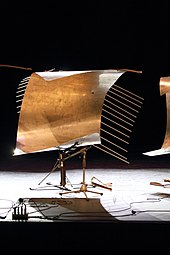Steel quartet

The Stahlquartett is an ensemble for new music from Dresden founded in summer 2001 . To produce its music, it uses the so-called " steel celli ". These are specially made string instruments made of iron that are made to sound with a bow .
History and contributors
The founder of the ensemble is the instrument maker, musician, composer and singer Jan Heinke, who was born in Dresden in 1968. He dealt with overtone singing and studied jazz saxophone at the HfM Dresden . He began building simple sound objects in the 1990s. The discovery Robert Rutmans mid-1990s gave him the impetus to more complex house developments, which in 1999 establishing the ensemble Steel harmony resulted from the 2001 Steel Quartet was born.
Alexander Fülle, who was also born in Dresden in 1972, is one of the founding members of the ensemble. He had piano lessons from 1980 to 1987. After graduating from high school, he majored in piano and studied jazz / rock / pop at the HfM Dresden. During a six-month study visit to Columbus (Ohio) , he took part in workshops and courses with John Abercrombie , Andy Laverne and Frank Mantooth .
Peter Andreas, b. 1970, lives and works in Dresden. He studied composition at the HfM Dresden and then for two years composition with a focus on electronic music. He has been a member of the ensemble since 1999.
Michael Antoni, b. 1972 in Dresden, lives as a freelance musician and teacher in Berlin. After studying musicology for two years at the TU Dresden , he switched to the HfM Dresden to study classical singing. He has been a member of the steel quartet since 2004 .
Steel celli
The so-called steel cellos are, despite their unusual shape and their unusual (more reminiscent of electronic music ) sound, purely acoustic string instruments - albeit with steel rods instead of strings. They were designed by Jan Heinke and built together with Albrecht Morgenstern in a historic blacksmith's shop in Olbernhau in the Ore Mountains . “Very impressive, this steel cello. Man high. An arm span wide. Weighs 50 kilos. ”The impetus came from Robert Rutman's Bow Chimes from the 1960s - a metal sculpture that can be used to create sounds. The steel cellos used by the steel quartet are completely different from the steel cello also developed by Robert Rutman . Jan Heinke mentions the nail violins from Mozart's time, Ernst Chladni's experiments with swinging plates around 1800 and various roller stick games from the Romantic era as further influences . With these instruments, the range of the ensemble usually corresponds to that of a classical string quartet, but it can be expanded to the limits of what is audible . The steel celli in this form are unique in the world and are only used by the steel quartet.
A steel cello consists of a metal stand on which two curved iron girders are mounted. 13 rods of different lengths and thicknesses made of stainless steel are attached to these iron girders, which determine the respective pitch. A sheet of stainless steel represents the resonance body. The bars are painted on both sides of the iron girders, so there are four equally tuned chromatic scales of one octave each on each instrument. The range is different on each instrument, the entire range of the steel quartet ranges from C1 to c4 and is therefore larger than the range of a normal string quartet. Typical of the steel cello are its sound and the extremely slow tone development in the lower registers. Due to the design, low notes take a long time to vibrate and sound completely. This results in a speed limit, which influences the way the steel quartet makes music. The sound is mainly shaped by the resonance body. Sounds that are particularly rich in overtones are created, which can be superimposed on the sheet metal and thus create further sounds. The timbre changes from the very rough metallic sounds typical of the steel cello to sounds that are reminiscent of the organ, trombone or orchestra.
repertoire
The steel quartet makes use of the special features of the steel celli and allows them to flow into the music. This results in arrangements of already existing works, which open up new perspectives for the reception of this often firmly determined music. In addition, the possibilities of the instruments are explored and presented in specially composed works. The ensemble's repertoire includes works by Johann Sebastian Bach , Ludwig van Beethoven , Béla Bartók to Björk or Wayne Shorter and their own compositions. Alexander Fülle says: “What appeals to me is independence from any genre. We can compose our own, that is also an important point, we can interpret classical pieces, modern music, but we can also play pop. "Referring to the well-known Air from Bach's orchestral suites, he said:" We grudgingly play a reference piece every now and then, where you can see: Ah, you know that, aha, that's how it sounds. So that you can even imagine it! But otherwise we have little educational intentions with this music. "
Publications
- 2012: Steel Quartet
Web links
Individual evidence
- ↑ a b c Heike Schwarzer: No concert without questions www.deutschlandfunk.de (accessed on July 14, 2018)




